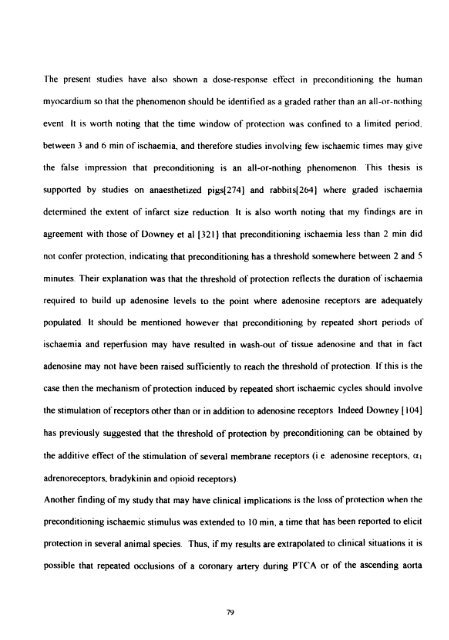ischaemic preconditioning of the human heart. - Leicester Research ...
ischaemic preconditioning of the human heart. - Leicester Research ...
ischaemic preconditioning of the human heart. - Leicester Research ...
Create successful ePaper yourself
Turn your PDF publications into a flip-book with our unique Google optimized e-Paper software.
'rhe present studies have also shown a dose-response etfect in <strong>preconditioning</strong> <strong>the</strong> <strong>human</strong><br />
myocardium so that <strong>the</strong> phenomenon should be identified as a graded ra<strong>the</strong>r than an all-or-nothing<br />
event. It is worth noting that <strong>the</strong> time window <strong>of</strong> protection was confined to a limited period,<br />
between 3 and 6 min <strong>of</strong> ischaernia, and <strong>the</strong>refore studies involving few ischaernic times may give<br />
<strong>the</strong> false impression that <strong>preconditioning</strong> is an all-or-nothing phenomenon. This <strong>the</strong>sis is<br />
supported by studies on anaes<strong>the</strong>tizcd pigs[2741 and rabbits[2641 where graded ischaernia<br />
determined <strong>the</strong> extent <strong>of</strong> infarct size reduction. It Is also worth noting that my findings are in<br />
agreement with those <strong>of</strong> Downey et al [3211 that <strong>preconditioning</strong> ischaernia less than 2 min did<br />
not confer protection, indicating that <strong>preconditioning</strong> has a threshold somewhere between 2 and 5<br />
minutes. Their explanation was that <strong>the</strong> threshold <strong>of</strong> protection reflects <strong>the</strong> duration <strong>of</strong> ischaernia<br />
required to build up adenosine levels to <strong>the</strong> point where adenosine receptors are adequately<br />
populated. It should be mentioned however that <strong>preconditioning</strong> by repeated short periods <strong>of</strong><br />
ischaernia and reperfusion may have resulted in wash-out <strong>of</strong> tissue adenosine and that in fact<br />
adenosine may not have been raised sufficiently to reach <strong>the</strong> threshold <strong>of</strong> protection. If this is <strong>the</strong><br />
case <strong>the</strong>n <strong>the</strong> mechanism <strong>of</strong> protection induced by repeated short ischaernic cycles should involve<br />
<strong>the</strong> stimulation <strong>of</strong> receptors o<strong>the</strong>r than or in addition to adenosine receptors. Indeed Downey [ 104]<br />
has previously suggested that <strong>the</strong> threshold <strong>of</strong> protection by <strong>preconditioning</strong> can be obtained by<br />
<strong>the</strong> additive effect <strong>of</strong> <strong>the</strong> stimulation <strong>of</strong> several membrane receptors (i e. adenosine receptors, ct,<br />
adrenoreceptors, bradykinin and oploid receptors).<br />
Ano<strong>the</strong>r finding <strong>of</strong> my study that may have clinical implications is <strong>the</strong> loss <strong>of</strong> protection when <strong>the</strong><br />
<strong>preconditioning</strong> <strong>ischaemic</strong> stimulus was extended to 10 min, a time that has been reported to elicit<br />
protection in several animal species. Thus, if my results are extrapolated to clinical situations it is<br />
possible that repeated occlusions <strong>of</strong> a coronary anery dunng PTCA or <strong>of</strong> <strong>the</strong> ascending aorta<br />
79














